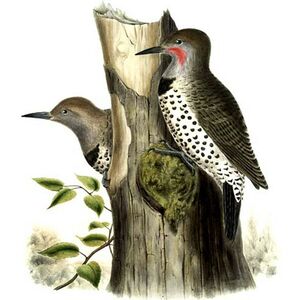

Next time you see an interesting bird that isn’t hummer trying to take advantage of sweet nectar, you might be seeing a flicker at your feeder! Offering seed may keep them away from the feeder and allow your hummers to eat in peace. Male and female plumage is similar, but males have a large. The young flickers will leave the nest about 25 days after hatching. Plumage/Description: Flickers are the largest woodpecker species that occurs in Central Arizona. About 6-8 eggs are laid, and both male and female will incubate the eggs for about 12 days. This member of the woodpecker family is seen in the hotter climates of. Both male and female will take part in the building of the nest, which generally is a 2 week process. The Gilded Flicker is the southern warm-blooded cousin of the Northern Flicker. Anting can also be done to remove the distasteful chemicals and make the insects more appetizing to eat.įlickers tend to be cavity nesters, but will take up home in an appropriately sized and situated birdhouse. The insects secrete liquids that contain chemicals that act as an insecticide, miticide, fungicide, and bactericide. They often feed from the ground because their primary food is insects.Īlthough ants can make up about 45% of their diet, Northern Flickers also participate in an activity known as “anting.” Anting is when birds rub insects on their feathers, to assist in preening, in order to avoid harmful parasites. Photo about Gilded Flicker Flying To Its Nest Hole In A Saguaro Cactus, Saguaro National Park, Tucson, Arizona.

Often found in wooded areas, you will see Northern Flickers among the tree line or moving about on the ground. They are one of the few members of the woodpecker family that migrate. In these cases, hot pink represents known breeding range, and lighter pink the extrapolated breeding range. Hot pink / magenta: For some birds, breeding data was limited, and was supplemented by extrapolation to include likely breeding range. The Northern Flicker, native to North America and parts of Central America, Cuba, and the Cayman Islands, is a medium-sized member of the woodpecker family. Gilded Flicker Colaptes chrysoides Temporary Map Key. This bird is the flicker and may be visiting a feeder near you! In the 1960s, the Gilded Flicker, Red-shafted and Yellow-shafted Flickers were all grouped together as conspecifics (subspecies) of the Northern Flicker. A group of flickers has several names: a guttering, a menorah, and a Peterson. These birds are almost as big as some feeders, and have a long bill and tongue, similar to a hummingbird. The Gilded Flicker (Colaptes chrysoides) - also known as Cape Gilded or Common Flicker - is one of the larger woodpeckers in the Picidae family. They are closely related to the more widespread Northern Flicker.There has been some buzz about a new bird frequenting hummingbird feeders. In the winter when ants and other insects are not active Gilded Flickers eat winter fruits and seeds. But they captured this play time the two birds were enjoying. After the dance they took turns hiding behind a pot or a plant and then popping out to startle the other, a combination of hide-and-seek and peek-a-boo. I grabbed my camera and took some pictures through the glass – they are not great photos. Last November I looked out the window and saw two Gilded Flickers on the ground in the backyard. They were dancing, stretching their necks to the sky and then bowing to each other and shuffling in circles together.
/northern-flicker-5a26e69047c26600377464e0.jpg)
After about a month the meal train stops, forcing the young out of the nest and into the practice of finding their own food. Later connecting with Caleb Winn on drums, we now reside in Joshua Tree, CA. Some call it the edge of is definitely somewhere. The parents take turns incubating and later feeding the young. Jamie Hafler & Cristie Carter met in Wonder Valley, CA. In April the female lays 3-4 eggs inside the cool, dim, unlined nest. That makes Gilded Flickers one of my favorite birds! These residents of the Sonoran Desert typically live near saguaro cacti, where they excavate their cavity nests. They visit us because of our ants, ants being their favorite food. Golden yellow underwings distinguish the Gilded Flicker from the Northern Flicker found within the same. We commonly see these large woodpeckers on the ground in our yard in the warm season. The Gilded Flicker (Colaptes chrysoides) is a large-sized woodpecker (mean length of 29 cm (11 in)) of the Sonoran, Yuma, and eastern Colorado Desert regions of the southwestern United States and northwestern Mexico including all of the Baja Peninsula except the extreme northwestern region. This is a flamboyantly colored bird, and the beautiful yellow undersides of the wings and tail are only part of the story. Gilded Flicker have similar glory hidden away on the undersides of their wings. I once visited a church in Mexico where workers on scaffolding were hammering paper thin sheets of gold onto the interior walls, “gilding” them. Male Gilded Flickers sport a red moustache


 0 kommentar(er)
0 kommentar(er)
